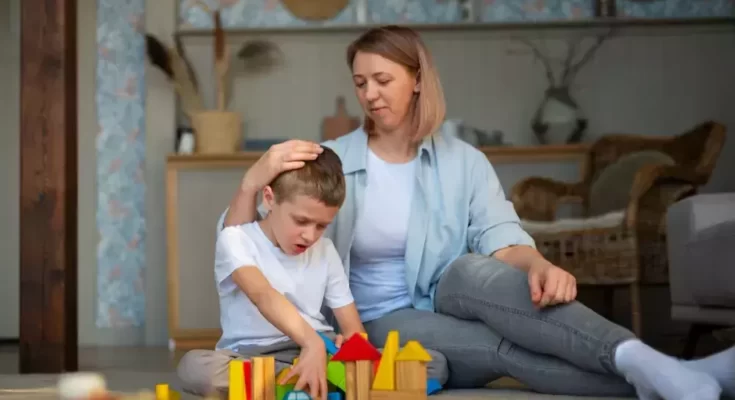Autism can vary from child to child, and not all children with Autism exhibit the same symptoms. However, some early signs that parents can look for in young children might indicate the possibility of Autism. The presence of these signs does not necessarily mean that a child is autistic.
Still, it may evoke further evaluation by a healthcare professional, such as a pediatrician or a developmental specialist. Early intervention can be crucial and helpful for children with Autism to support their developmental and communication skills.
What are the early signs of Autism in 2-year-olds?
Here are some early signs of Autism in 2-year-olds:
1 Communication:
- In the first few years of a child, social interaction and communication cues are essential areas to watch out for Autism.
- Typical social, emotional, and communication development in children includes responding to their names, making eye contact, and using gestures. An autistic child generally takes a longer time to comprehend specific communication cues, which may be indicated by :
- Delayed or limited speech development, for example, the child’s vocabulary may be limited to a particular set of words like mama or papa, but have difficulty using more phrases.
- Difficulty initiating or sustaining conversations; for example, the child may need to respond appropriately to a question or keep repeating the same thing repeatedly.
- Repetitive speech patterns include repeating phrases without understanding their meaning; for example, the child may repeat the same thing they might have heard on TV or Radio and use them without context.
- Difficulty in expressing needs or desires or using gestures; for example, they may want something but cannot indicate or tell their parents.
Also Read: Speech Therapists – What Do They Do and Why Do We Need Them?
2 Social interaction:
They might:
- Not be using eye contact to get someone’s attention – for example, they might not always look at you and then at a snap or snack keep looking at you continuously to show you they want it, or not look back at towards you when they see something that excites them, they might point to or hold up objects to show you things – for example, they might not point to a dog and look back at you to make sure you’ve seen it, or they might drop a cloth or toy in your lap and walk away instead of keeping it up and looking at the same for more extended period.
- Not consistently responding to their name being called or using gestures on their own – for example, they might not wave goodbye or clap without being asked to, or they might not nod for Yes or shake their head for No.
- Do not smile back at you or other people when you smile at them.
- Rarely copy other people’s actions or try to learn from them, for example, combing their hair when you comb yours.
- It sounds like they’re talking with you when they mumble or might not mumble.
- Need help understanding simple, one-line instructions – for example, ‘Give me the paper’ or ‘Show me the pot.’
Also Read: The Best Autism Supplements & Vitamins
3 Relationships and play
They might:
- Rarely show interest in other children or their activities – for example, they might not look towards them or try to get their attention with games like peekaboo or round the garden.
- Rarely do they pretend to play – for example, they might not even pretend to feed a teddy bear or play house.
- Rarely share toys with others – for example, they might not hand over their belongings to anyone.
4 Behavioral Early Signs of Autism
- If young children are autistic, they might
- Have an extreme interest in particular objects or toys and do not want to let go – for example, play mostly with cars or dolls and get irritated when it is taken away.
- They have regular repetitive behaviors and actions – for example, they might spin the wheels of a toy car or their clothes repeatedly or take the clothes on and off the doll.
5 Repeated movements
- They interact with toys and objects unexpectedly as per their liking. For example, they might enjoy repeatedly lining up things, placing toys into piles, or arranging particular objects.
- Display a strong interest in specific activities or items and become upset when unable to participate, such as repeatedly watching the same TV show for multiple sessions.
6 Continuous routines
- If young children are autistic, they might be easily upset by a change and usually prefer routines. For example, they might want to follow the same route to a particular place, such as a child care center or a grandparent’s house.
7 Repetitive movements for items
- If young children are autistic, they might repeatedly move body movements or move their bodies unexpectedly. For example, they might:
- Arch their backs
- Flap their hands
- Hold their arms stiffly.
- Walk on the tips of their toes
8 Sensory sensitivities
- An autistic child is susceptible to external stimuli and might react knee-jerk to external events beyond their control, such as environmental or social stimuli.
- If young children are autistic, they might:
- Be sensitive to the ambiance of an unknown place – for example, they might get easily upset by noise or bright lights as compared to other children, and they prefer that their environment stays the same – for example, they’ll likely be eating only foods with certain textures or colors, or they’ll want to wear the same set of clothes each day.
- Enjoy seeking out sensations familiar to them. For example, they might rub their hands or objects on their lips or face things.
It can be helpful to remember that early intervention is the key if you suspect that the child may have Autism. If any of the above signs are displayed by a 2-year-old, it’s a good idea to discuss your concerns with a pediatrician or a developmental specialist. They can conduct a quantitative and qualitative evaluation to determine whether further assessment and intervention are necessary.
How to deal with early Autism?
Early identification of Autism can lead to early intervention, which can help children with Autism develop essential skills and reach their full potential. Parents, caregivers, and healthcare professionals are vital in observing and addressing these signs. Through early intervention, therapy, and a supportive environment, many children with Autism can thrive and lead fulfilling lives. Therefore, individual support and understanding are essential in helping children with Autism and their families navigate their journey towards a brighter future.
Conclusion-
In conclusion, recognizing early signs of Autism in 2-year-olds is crucial for timely intervention and support. While it’s important to remember that every child develops at their own pace, being vigilant for potential red flags can significantly affect their developmental trajectory. As mentioned above, some critical early signs to watch include social difficulties, communication challenges, repetitive behaviors, and sensory sensitivities.
Frequently Asked Questions
What does Autism at two years of age look like?
It looks like an increase in behavior differences in play, intimation, and feeding habits.
What does level one Autism look like in 2-year-olds?
A child with level one of Autism helps in understanding the complete sentences and having difficulty engaging in fourth conversation.
Can one be tested for Autism in two years?
ASD can be detected at 18 months of age.
What are the signs of mild Autism?
Repetitive play and verbal expression relating to curtain activities like repetitive routines.
What are the red flags for Autism in a two-year-old?
The early signs of Autism can be social skill problems and communication.

Written by
Garima Yadav
Source link



